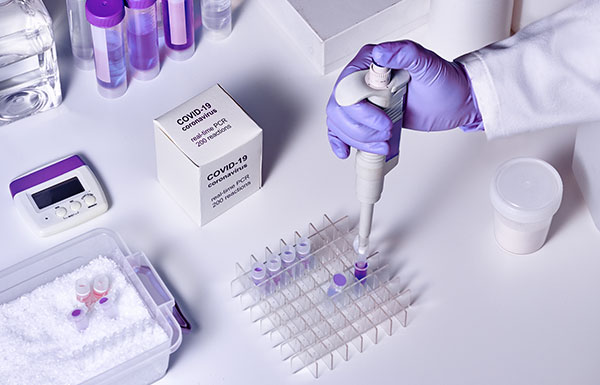Applications of Nucleic Acid Testing in Molecular Diagnostics

What is Nucleic Acid Testing?
Nucleic acid amplification or Nucleic acid testing diagnosis is frequently referred to as NAT or NAAT. It is a technique that involves magnification and recognition of genetic material, the nucleic acids, and DNA, or RNA for diagnosis.
Although all living beings’ genetic material is composed of RNA or DNA, differences exist in genome sequences. This genetic variation makes NAT an ideal technique for identifying infectious diseases, cancer, genetic disorders, and mitochondrial disorders.
A molecular diagnostic device could address needs in many disease areas worldwide, both chronic and infectious. NAT for infectious diseases is almost exclusively performed in centralized laboratories using high-end instrumentation and skilled personnel. However, near-patient testing in a hospital, doctor’s office, clinic, or home, is defined as POC (point of care). It offers advantages when a rapid answer is required, or when suitable facilities or logistics chains are nonexistent.
Detection of nucleic acid in molecular diagnostics
Each microbe has a rare complement of DNA or RNA. The nucleic acid sequence consisting of nucleic acids is the ideal molecular fingerprint aiding identification for many viral pathogens. RT-PCR and PCR are used to analyze the levels of microbial double-stranded DNA in clinical samples. Other single-stranded detection methods require higher concentrations or are too tedious or bulky to detect.
Molecular diagnostics may carry a more considerable cost burden than other laboratory techniques. Only those molecular diagnostics that identify pathogens via shed surface proteins or antibodies in human serum. However, the specificity, speed, and sensitivity of based molecular testing offer several advantages over the more traditional methods.
Other Therapeutic Areas
1. Microbiology and infectious diseases: Real-time PCR changed how clinical laboratories detect human pathogens. It is predicted that 1% of bacteria present on earth have been described using cultivation technology. Additionally, molecular testing can identify hazardous microbes without risk to laboratory staff.
2. Blood screening: Globally, more than 90 million blood donations are collected every year. Lab screening of donated blood and products for infectious diseases is crucial. It is a safety measure to secure patients and prevent the spread of diseases.
NAT detects viral infection by directly testing viral nucleic acid-based for screening blood and plasma samples. The global trend toward adopting this technology demonstrates its effectiveness in increasing the safety of blood supplies.
3. Tuberculosis: TB is a disease of high public health priority owing to the increase in multi-drug-resistant strains. Rapid diagnosis and drug awareness testing can limit the spread of TB and facilitate effective treatment.
4. Methicillin-resistant Staphylococcus aureus surveillance and diagnosis: Staphylococcus aureus is a common infection acquired in the hospital. It is the leading cause of ventilator-associated pneumonia and surgical site infections. The incidence of Staphylococcus aureus infections is increasing, particularly in the USA. NAT has been recommended recently by the Clinical and Laboratory Standards Institute active.
5. Infant HIV diagnosis: Infants diagnosed at an early stage and timely intervention with antiretroviral drugs are essential. It extends the life expectancy of HIV-1-infected infants. Infant HIV diagnosis using standard serological assays is compromised owing to the presence of maternal HIV antibodies.
6. Human genetics testing via nucleic acid markers: Molecular testing has been engaged to identify countless human host markers via DNA found in human cells.
7. Fetal diagnosis: Fetal diagnosis employs various techniques to determine an unborn fetus’s health and condition.
8. Inherited diseases: Carrier screening and testing of parents while the preparation for pregnancy is used to identify genetic mutations if not specified, could cause severe inherited disorders.
9. Cancer markers: Cancer research continues to focus on new molecular markers. Combining molecular markers into existing histomorphologic analysis has already contributed to new stratification. Moreover, a molecular definition of cancer may often guide therapy and allow the monitoring of residual disease.
Conclusion
The introduction of NAT in clinical laboratories has enormously improved the disclosure of infections. Viral infection can be cured with tests at hand that can inform the physician if the patient is responding, developing resistance. The current decade has witnessed a rise in the number of commercial molecular tests used in practice.
In 2013, over seventy per cent of molecular diagnostics tests were sold by five leading healthcare companies. (Abbott, Hologic, Roche, Becton Dickenson, and Qiagen). Nevertheless, in recent years the number of companies developing molecular tests has grown remarkably.
In the healthcare industry, roughly 300 companies work actively in evolving molecular diagnostics. These companies highlight the importance and utility of nucleic acid testing.
In the future, it is likely that NAT will penetrate the markets in developing and emerging countries. It is not surprising that molecular testing is widely available and applicable to healthcare globally. However, it is quite challenging to manufacture nucleic acid tests and adapt technologies and platforms, especially in resource-limited settings.
The future of molecular testing may involve a reduction in time to test results and a reduction in assay instrument complexity. Molecular testing will also reduce the number and training expertise of staff required to perform such assays.
To learn more about nucleic acid testing in molecular diagnostics, and our extensive range of NATtrol panels and external run controls, contact Helvetica Health Care today.
